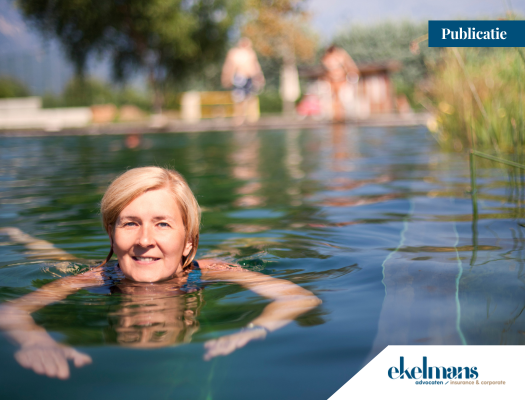
In the Netherlands, there are more than 700 locations officially designated as safe places to swim. Many more places are expected to be unofficially used for recreational swimming. Although over 90% of the Dutch master the basics of swimming, swimming in outdoor areas has been proven to remain a risky activity. In this article Diederik Hulsbergen will share an insight in recent Dutch case law on liability for owners of outdoor areas that are used for recreational swimming.
Court of Limburg, 26 October 2023
A 16 year old boy sustained a high spinal cord injury after diving into shallow water in a lake in a nature reserve in the Dutch province Limburg. Het Landschap is the manager/owner of the nature reserve. The boy, claimant in the following legal procedure, deems Het Landschap and its liability insurer Nationale Nederlanden (hereinafter: NN) liable for the damages he suffered. According to the claimant, Het Landschap and NN are liable on grounds of wrongful act (article 6:162 of the Dutch Civil Code). The Court of Limburg ruled in this case on 26 October 2023.[1] The verdict: the owner of the nature reserve and its liability insurer are liable and have to compensate the boys damages for 80%.
Facts and views of the matter
In this case, the claimant argued that Het Landschap and NN are liable because the owner of a wild swimming area has a duty of care to prevent endangering circumstances. According to the claimant, at the lake where he dived into the shallow water, swimming was frequent. At the time of the accident, because of the restrictions in place due to the COVID-19 pandemic, there was even more swimming than usual, as few other recreational opportunities existed. This was known to Het Landschap. It was also known that the water there was shallow in many places. The claimant argued that it is a fact of common knowledge that younger recreationists – due to their rash and inexperience – tend not to exercise ideal caution in their recreational activities. Therefore, there was a high probability that a younger recreant would dive into the water without first checking how deep the water was. This was foreseeable to Het Landschap, the claimant argued.
Het Landschap argued that the nature reserve is not designed as a swimming recreation area, nor is it designated as a swimming location. Het Landschap also had not promoted the lake as a swimming location. As such, the conditions at the site do not create a hazard. Shallow water and swimming are both not hazardous in general and the likelihood of danger is low. Danger only occurs if someone decides to dive into the shallow water while running. At the accident site, there were no indicators to assume that diving could be done responsibly. If it were assumed that there was little objection to taking measures, it would mean that warning signs would have to be put up at all places in the Netherlands, including all nature reserves where water occurs. Het Landschap does not have the financial resources to provide signs on the approximately 9,000 hectares it currently owns and manages. So taking action was objectionable.
The court’s considerations
The Court of Limburg rules in favor of the claimant and ruled that Het Landschap and NN are liable for the damages of the claimant, due to unlawful endangerment.
Established Supreme Court case law determines that the following circumstances must be tested to assess whether unlawful endangerment exists:
- the extent to which disregard for due caution is likely,
- the likelihood of accidents occurring as a result,
- the severity of the possible consequences, and
- the extent to which taking safety measures would be objectionable.
The defense of Het Landschap and NN that Het Landschap does not have a duty of care because the nature reserve is not designed as a swimming recreation area fails. According to the court, the mere fact that this is so, does not relieve the owner of every duty of care.
The court considered to be a decisive factor that the lake was structurally used as an unofficial recreational swimming site. Also, a survey conducted by an expert showed that Het Landschap was aware of this fact. According to the court, it is to be expected that people do not always enter the water with caution and could therefore dive from the bank into the water. Given that the water is shallow for the first few metres and it is a fact of common knowledge that diving into shallow water can cause serious injuries, the likelihood of subsequent accidents with serious consequences is high. The court therefore held that there was a dangerous situation.
In the court’s view, it is not inconvenient for Het Landschap to warn recreational users of the shallow water. This can easily be done by placing warning signs in the water at the spot, which are now missing. In view of the above, the court finds that Het Landschap breached its duty of care by failing to post warning signs. In doing so, Het Landschap committed a wrongful act towards the claimant. Het Landschap and NN are therefore liable for the damages caused by the sustained injury.
The court however also acknowledges that the claimant should have been more careful himself, and that he is half (50%) at fault for the accident. Since he did not know the spot where he dived and it was not an official swimming location, he should have first checked how deep the water was. Because he did not do so, he did not exercise the caution he should have exercised and thus contributed significantly to his accident. After weighing the circumstances of the case, the court applies a so called ‘fairness correction’, such that the extent of the liability of Het Landschap and NN is set at 80%. Such a correction can be applied, inter alia, because that the liable party has liability insurance and therefore has greater capacity to pay the financial damages.
A comparison with other recent case law: Court of Amsterdam, 31 march 2022
The prevalent view in Dutch case law is that the owner of a site that – in theory – could be used for recreational swimming, should anticipate unthoughtful and inattentive swimming behavior of visitors.[2] On 31 march 2022, the Court of Amsterdam remarkably ruled very opposite to this view.[3]
Facts and views of the matter
In this case, the municipality of Amsterdam was held liable when a visitor of the city suffered a severe lower spinal cord injury from diving head first into a shallow part of the IJ Harbor, located in Amsterdam. The water of the IJ harbor is surrounded by a quay on one side, a building on the other side and – between them – a stone terrace. The last step of this terrace is underwater, overflowing into a concrete slab. This makes this part of the water in the IJ harbor very shallow. The same question as the one in the case discussed above, was assessed by the court of Amsterdam: is the owner of the water liable for the claimant’s damages due to the lack of warning for the shallow water, causing an unlawful endangerment?
Very notably, the court of Amsterdam starts its ruling by considering it facts of common knowledge that diving into shallow water can cause serious injuries and that it is dangerous to dive into water of which one does not know how deep it is. In the case reviewed above, the court of Limburg considered that these common knowledges explicitly urged a warning from the owner of the lake. The court of Amsterdam however considers oppositely that these common knowledges make the probability that a visitor is not cautious when diving from the quay in the harbor, to be small. The descending terrace into the water should have been an indication for the claimant that the water was shallow. In this context, the court stated that the probability of someone entering the water in this area of the harbor without checking the depth is very low. This is a very small chance of a great danger.
Apparently, the court also considers as equally relevant that it is forbidden to swim in this area. This factor was put forward by the municipality. For this reason, the municipality is not obliged to take safety measures, the court ruled. The municipality is therefore not liable for the damages of the claimant. As will become clear below, the key consideration of the court appears to be:
“The person who jumps or dives into the water at the present location, where it is forbidden to swim, relatively close to the stone terrace steps, (…) is not behaving as visitors to that location generally tend to behave. In any case, that behavior is not foreseeable to the extent that the municipality should have taken measures.”
An unexpected turn of events: the ruling is overturned by the same court
The ruling mentioned above was an interlocutory judgment. In general, interlocutory rulings are binding: the court cannot depart from this ruling at a later stage of the proceedings. The claimant however initiated proceedings on the merits based on new facts, which would shed a different light on the matter. The claimant obtained internal documents from the municipality, which proved that the municipality was aware that people regularly swim there. The documents also showed that there was no ban on swimming at the site and that the area was identified as a place where people often swim recreationally.
On 21 February 2024, the court of Amsterdam overrules the interlocutory judgement with a revised judgement.[4] The court rules that the distinction between a no-swimming spot and a wild swimming spot is relevant to the duty of care to be observed by the municipality. The municipal documents that have become available show that the municipality was aware of safety risks at wild swimming spots in the city and that it is taking measures to improve physical safety at these spots.
In the interlocutory judgment, the court ruled that the likelihood of a careless visitor diving into the shallow part of the water and thereby failing to meet the required degree of caution was very low. It now reverses that assessment. The visual material (photos and videos) showed by the claimant during the proceedings, show dozens of people jumping or diving into the water from the quay on busy summer days. Therefore, the likelihood of accidents arising from that behavior in this area is considered high. On these grounds, the municipality is liable after all. Nonetheless, the court held that there was also fault on the part of the claimant, resulting in 20% of the dameges remaining at his own expense.
Relevant insights
Despite the court of Amsterdam overruling its own previous judgment, these rulings still provide some interesting insights.
Common knowledge as a factor for (not) being liable
Both courts use ‘common knowledges’ for their assessment of the existence of unlawful endangerment. What is conspicuous is how the courts attribute these circumstances to the different parties. Noteworthy is the insight that a very present likelihood of accidents occurring, as well as a high severity of the possible consequences of those accidents, seem to be able to decrease the extent to which disregard for due caution is likely. And the lesser the extent to which disregard to caution is likely, the smaller the chance of the owner being liable. Looking at other similar case law, this reasoning seems rather unique. The tendency in most case law is for owners of recreational swimming areas to be under a strict duty of care, and are often deemed liable in court. Despite this judgement later being overruled, the court of Amsterdam’s method of thinking is quite innovative and might even be used to defendants advantage in future cases.
Other factors considered (equally) important
What becomes clear from the overruling, is that whether the owner of a water is liable for personal injury can also highly depend on the circumstance that it is forbidden to swim in the particular area, as well as whether or not the owner reasonably could be aware of the presence of recreational swimmers. The importance of this latter factor was also emphasized by the court of Limburg. Furthermore, both courts ruled that part of the damages remain at the expense of the claimant, due to their own carelessness. The amount of damages remaining at own expense can vary, and depends on the circumstances of the case.
Conclusion
The duty of care for owners of recreational waters has proven to be a strict one. It does seem to matter whether or not the area has a prohibiton of swimming. Even then, the scope of the duty of care must be assessed according to the circumstances of the case. Nonetheless, the claimants own responsibility will always remain a factor in the assessment of the case.
[1] Court of Limburg, 26 October 2023, case no. ECLI:NL:RBLIM:2023:6252.
[2] For example: Court of Northern Netherlands, 14 February 2017, case no. ECLI:NL:RBNNE:2017:951; : Court of Northern Netherlands, 7 July 2022, case no. ECLI:NL:RBNHO:2022:5915.
[3] Court of Amsterdam, 31 march 2022, case no. ECLI:NL:RBAMS:2022:1755.
[4] Court of Amsterdam, 21 February 2024, case no. ECLI:NL:RBAMS:2024:1019.
Author
Both on the pitch and in his work, Diederik Hulsbergen has a great passion for sports. As a lawyer, Diederik not only deals with various insurance law issues, but also advises and litigates in various sports law cases. He has experience in sports-related association law, employment law, liability, personal injury, contracts and disciplinary law.







